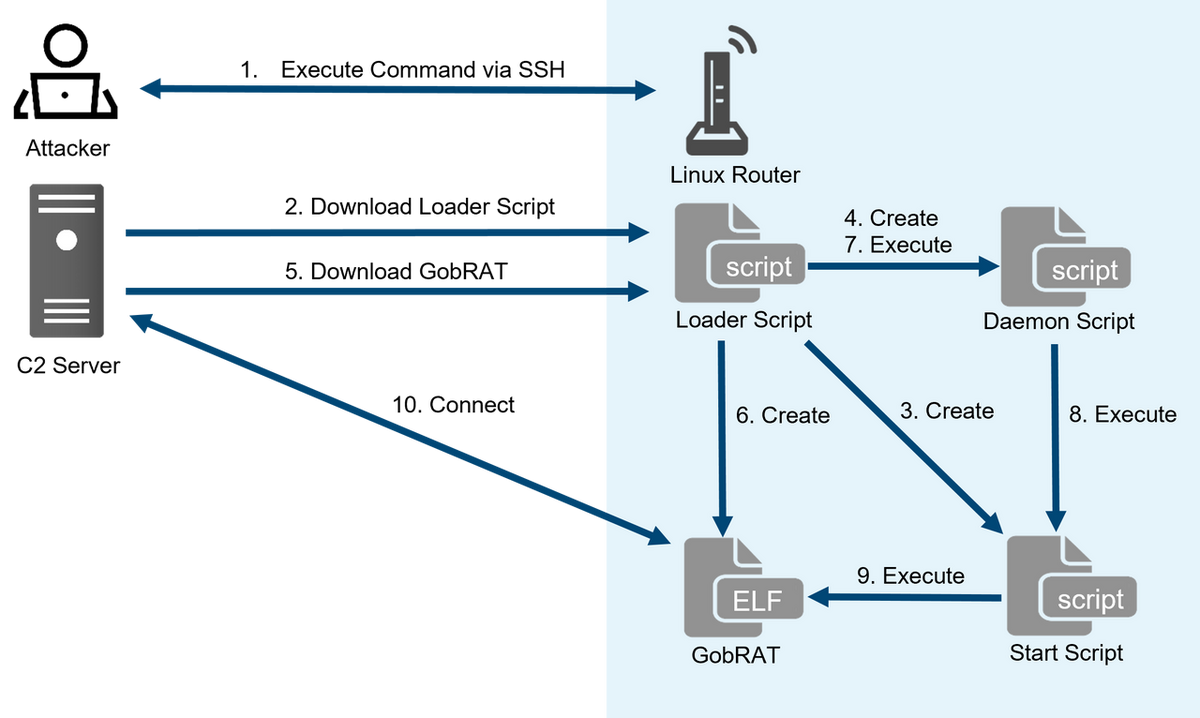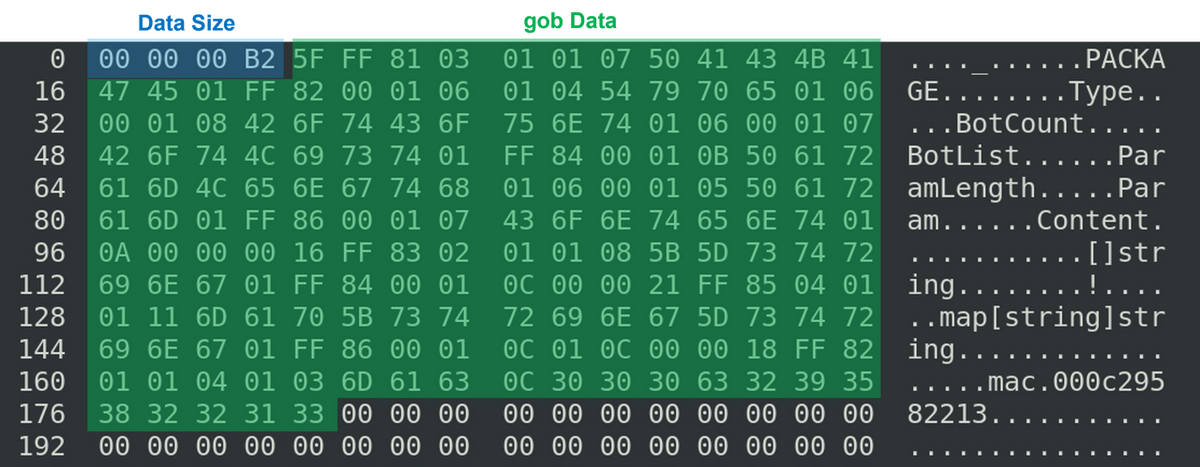GobRAT malware written in Go language targeting Linux routers
JPCERT/CC has confirmed attacks that infected routers in Japan with malware around February 2023. This blog article explains the details of the attack confirmed by JPCERT/CC and GobRAT malware, which was used in the attack.
Attack flow up to malware execution
Initially, the attacker targets a router whose WEBUI is open to the public, executes scripts possibly by using vulnerabilities, and finally infects the GobRAT. Figure 1 shows the flow of the attack until GobRAT infects the router.

Loader Script works as a loader, containing functions such as generating various scripts and downloading GobRAT. The SSH public key, which is assumed to be used for the backdoor, is hard-coded in the script. In addition, since Loader Script uses crontab to register the file path of Start Script for persistence, GobRAT does not have such function. The functions of Loader Script are as follows:
- Disable Firewall function
- Download GobRAT for the target machine's architecture
- Create Start Script and make it persistent
- Create and run Daemon Script.
- Register a SSH public key in /root/.ssh/authorized_keys
Figure 2 is the code of Start Script that executes GobRAT. The script is unique in that it writes the startup time to a file named restart.log. In addition, this script executes GobRAT under the file name apached to make it look like a legitimate process.

Figure 3 is the code of Daemon Script. This script checks whether Start Script is running or not every 20 seconds, and if not, it starts the script. This code has been possibly prepared in case Start Script is terminated unexpectedly.

GobRAT Overview
GobRAT is a RAT written in Go language and communicates with C2 server via TLS and executes various commands. It is packed with UPX version 4 series, and samples for various architectures such as ARM, MIPS, x86, and x86-64 have been confirmed. GobRAT performs the following checks at startup and keeps the information within the sample itself.
- IP address and MAC address of itself
- Uptime by uptime command
- Network communication status by /proc/net/dev
The following sections describes the GobRAT’s communication method, encryption method, and commands to be executed.
Communication method
GobRAT uses TLS to send and receive data with its C2 server. Figure 4 shows an example of communication with the C2 server. The first 4 bytes indicate the size of the data, and the rest is gob[1] data. gob is a data serialization protocol available only in Go language. GobRAT uses gob for receiving commands and sending the results of command execution.

GobRAT defines gob data as a PACKAGE structure in the sample as follows.
type PACKAGE struct {
Type uint8 // CommandID
BotCount uint16 // Parameter
BotList []string // Command Parameter
ParamLength uint16 // Length of Param
Param map[string]string // Command Parameter
Content []uint8 // Command Parameter, Command Execution Result, etc
}
The fields used are different depending on the type of command, and string arrays, maps, and binary data are supported so that various types of parameters can be passed. In addition, while binary data can be stored in Content of the PACKAGE structure, map data with string is converted to binary data by encoding it with the json.Marshal function. The PACKAGE structure is used in various ways depending on the command, such as storing the data in Content, or converting the defined structure to binary data in the same way and storing it in Content.
Encryption Method
Strings such as C2 and Linux commands are encrypted and stored in the sample. Figure 5 shows the GobRAT's decryption function. AES128 CTR mode is used to decrypt strings, and the key and IV are hard-coded in the sample. The same key (050CFE3706380723433807193E03FE2F) and IV ("12345678abcdefgh") are used in all the confirmed samples. In addition, as shown in Figure 6, the codes that have probably been developed by the attacker, such as this decryption function, has a unique folder structure like aaa.com/bbb/me~.


Commands executed
GobRAT has 22 commands that are executed by the commands from the C2 server, and we have identified the following commands. Since the malware targets routers, you can see that most functions are related to communication, such as frpc, socks5, and reconfiguration of C2. See Appendix A for command details.
- Obtain machine Information
- Execute reverse shell
- Read/write files
- Configure new C2 and protocol
- Start socks5
- Execute file in /zone/frpc
- Attempt to login to sshd, Telnet, Redis, MySQL, PostgreSQL services running on another machine
GobRAT Analysis Tools
Since GobRAT uses gob for communication, if you want to emulate its communication with C2 to check commands, you need to create a program using Go language. Our C2 emulation tool that supports GobRAT analysis is available on GitHub. Please download it from the following webpage for your analysis.
JPCERTCC/aa-tools/GobRAT-Analysis - GitHub
https://github.com/JPCERTCC/aa-tools/tree/master/GobRAT-Analysis
In Closing
In recent years, different types of malware using Go language have been confirmed, and the GobRAT malware confirmed this time uses gob, which can only be handled by Go language, for communication. Please continuously beware of malware that infects routers, not limited to GobRAT, since they are difficult to detect. Please refer to Appendix B for C2 of the malware, Appendix C for the hash value of the script, and Appendix D for the hash value of the malware.
Yuma Masubuchi
Translated by Takumi Nakano
Appendix A: Commands
| Value | Contents |
|---|---|
| 0x0 | Update json data held in malware and acquire update results |
| 0x1 | Retrieve json data held in malware |
| 0x3 | Start reverse shell |
| 0x4 | End of reverse shell connection |
| 0x6 | Confirmation of reverse shell connection |
| 0x7 | Execute shell command for daemon |
| 0x8 | Execute shell command |
| 0xD | Read/write specified file |
| 0x10,0x11 | Read/write specified file |
| 0x16 | Obtain various machine information such as df command |
| 0x17 | Set new communication channel for TCP |
| 0x18 | Execute SOCKS5 proxy with specified port and password |
| 0x19 | Execute SOCKS5 proxy on specified port |
| 0x1a | New communication channel setting for UDP |
| 0x1b | Execute frpc after executing SOCKS5 proxy on port 5555 |
| 0x1f | Check for the existence of the specified file |
| 0x25 | Login attempts for SSH, telenet, redis, mysql, postgres |
| 0x27 | Configuration of specified goroutine |
| 0x2a | Scan to HTTP/HTTPS service of specified IP |
| 0x2D | Dictionary attack to HTTP/HTTPS service of specified IP |
| 0x30 | C2 configuration related |
| 0x31 | DDoS attacks on SYN, TCP, UDP, HTTP, ICMP |
Appendix B: C2
- https://su.vealcat.com
- http://su.vealcat.com:58888
- https://ktlvz.dnsfailover.net
- http://ktlvz.dnsfailover.net:58888
- su.vealcat.com
- ktlvz.dnsfailover.net
- wpksi.mefound.com
Appendix C: Hash values of the scripts
- 060acb2a5df6560acab9989d6f019fb311d88d5511f3eda0effcbd9fc6bd12bb
- feaef47defd8b4988e09c8b11967e20211b54e16e6df488780e2490d7c7fa02a
- 3e44c807a25a56f4068b5b8186eee5002eed6f26d665a8b791c472ad154585d1
- 60bcd645450e4c846238cf0e7226dc40c84c96eba99f6b2cffcd0ab4a391c8b3
Appendix D: Hash values of the malware
- a8b914df166fd0c94106f004e8ca0ca80a36c6f2623f87a4e9afe7d86b5b2e3a
- aeed77896de38802b85a19bfcb8f2a1d567538ddc1b045bcdb29cb9e05919b60
- 6748c22d76b8803e2deb3dad1e1fa7a8d8ff1e968eb340311fd82ea5d7277019
- e133e05d6941ef1c2e3281f1abb837c3e152fdeaffefde84ffe25338fe02c56d
- 43dc911a2e396791dc5a0f8996ae77ac527add02118adf66ac5c56291269527e
- af0292e4de92032ede613dc69373de7f5a182d9cbba1ed49f589ef484ad1ee3e
- 2c1566a2e03c63b67fbdd80b4a67535e9ed969ea3e3013f0ba503cfa58e287e3
- 98c05ae70e69e3585fc026e67b356421f0b3d6ab45b45e8cc5eb35f16fef130c
- 300a92a67940cfafeed1cf1c0af25f4869598ae58e615ecc559434111ab717cd
- a363dea1efda1991d6c10cc637e3ab7d8e4af4bd2d3938036f03633a2cb20e88
- 0c280f0b7c16c0d299e306d2c97b0bff3015352d2b3299cf485de189782a4e25
- f962b594a847f47473488a2b860094da45190738f2825d82afc308b2a250b5fb
- 4ceb27da700807be6aa3221022ef59ce6e9f1cda52838ae716746c1bbdee7c3d
- 3e1a03f1dd10c3e050b5f455f37e946c214762ed9516996418d34a246daed521
- 3bee59d74c24ef33351dc31ba697b99d41c8898685d143cd48bccdff707547c0
- c71ff7514c8b7c448a8c1982308aaffed94f435a65c9fdc8f0249a13095f665e
References
[1] Gobs of data
https://go.dev/blog/gob

